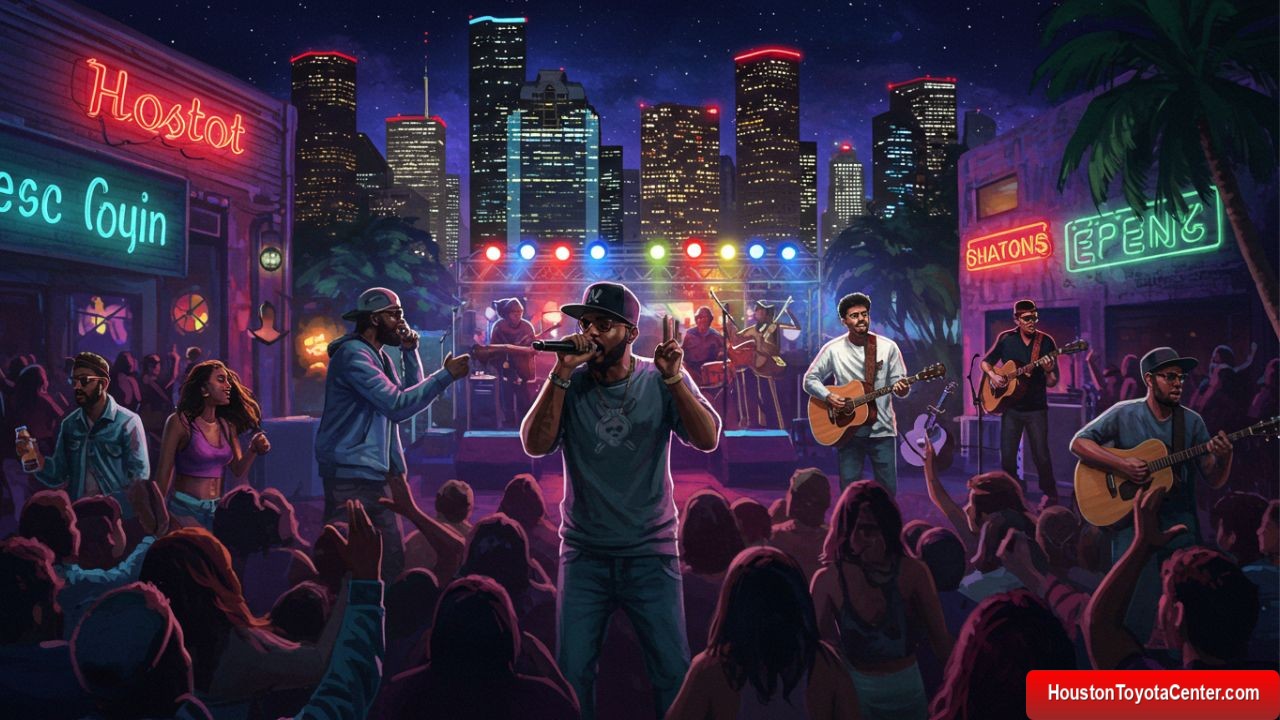Houston, Texas, has long been known as a cultural melting pot, and nowhere is this more evident than in its music scene. From blues and country roots to the rise of hip-hop and a thriving live music culture, Houston’s musical evolution reflects the city’s diverse population and rich history. Over the decades, Houston has produced influential artists, hosted iconic performances, and cultivated a music industry that blends genres and cultures into a distinct sound. This article explores the journey of Houston’s music scene — from its early foundations to the modern-day influence on global music.
Early Roots: Blues and Country Influence
Houston’s music story begins with the deep roots of blues and country music, shaped by African American and rural Southern traditions. In the early 20th century, migration patterns brought blues musicians from the Mississippi Delta and country artists from rural Texas into Houston, creating a fusion of sound that would define the city’s early music culture.
Blues in the Third Ward
The Third Ward, one of Houston’s oldest African American neighborhoods, became the heart of the city’s blues scene. Clubs like The Eldorado Ballroom were pivotal in giving a platform to legendary blues artists such as:
- Lightnin’ Hopkins – Known for his emotive guitar work and soulful lyrics, Hopkins became one of the most influential blues musicians in American history.
- Big Mama Thornton – Famous for her powerful voice and hits like “Hound Dog,” Thornton’s roots in Houston’s blues scene laid the groundwork for her success.
Country in Houston’s Honky-Tonks
Simultaneously, country music gained traction in Houston’s honky-tonk bars and dance halls. Venues like The Esquire Ballroom hosted rising stars and attracted national acts, giving country music a foothold in the city. Notable figures include:
FREE: Quickly identify and understand problems with your vehicle 🚘
CLICK HERE- Willie Nelson – Before becoming a country music icon, Nelson performed regularly in Houston.
- George Jones – Another major figure in Houston’s early country scene, Jones’ emotional ballads resonated with Texas audiences.
1950s–1970s: The Rise of Rock and Soul
As rock and roll swept the nation, Houston’s music scene adapted and thrived. The 1950s and 1960s saw a blend of rock, soul, and R&B emerge, led by local talent and visiting national acts.
Rock Influence
Houston became a popular stop on the national rock circuit. Venues like The Music Hall and Liberty Hall hosted legendary acts including:
- The Rolling Stones
- Jimi Hendrix
- Janis Joplin (a native Texan)
The Birth of Houston Soul
The city also produced a unique brand of soul music that fused gospel influences with rhythm and blues. Key players included:
- Archie Bell & The Drells – Known for their hit “Tighten Up,” which became a nationwide dance craze.
- Bobby “Blue” Bland – A blues and soul pioneer whose emotionally charged vocals left a lasting mark on the genre.
1980s–1990s: The Hip-Hop Revolution
Houston’s music identity took a dramatic turn in the 1980s and 1990s with the rise of hip-hop. The city’s distinct “chopped and screwed” sound, pioneered by DJ Screw, became a defining feature of Houston hip-hop.
The Rise of DJ Screw and the Chopped and Screwed Sound
DJ Screw slowed down rap beats and added heavy bass, creating a hypnotic, laid-back sound that influenced not only Houston but also the national hip-hop scene. His mixtapes became highly sought after, and his influence extended beyond Houston through collaborations with major artists.
Breakout Hip-Hop Stars
- Geto Boys – Their gritty storytelling and socially conscious lyrics brought Houston’s street culture to the mainstream.
- UGK (Underground Kingz) – Known for their Southern-fried beats and smooth delivery, UGK helped put Houston on the map as a hip-hop powerhouse.
2000s: Mainstream Success and Global Recognition
The 2000s marked Houston’s transition from a regional hub to a global music influencer. Hip-hop remained dominant, but Houston artists began to find mainstream success across multiple genres.
Beyoncé’s Rise to Stardom
No discussion of Houston’s music scene would be complete without mentioning Beyoncé. Born and raised in Houston, Beyoncé’s meteoric rise from Destiny’s Child to solo superstardom cemented her status as one of the most influential artists of all time.
The Impact of Swishahouse
Swishahouse Records, founded by Michael “5000” Watts, played a crucial role in the commercial rise of Houston rap. Artists like:
- Slim Thug
- Paul Wall
- Mike Jones
These artists brought Houston’s “chopped and screwed” style into the mainstream, with hits like “Still Tippin’” gaining national radio play.
2010s: Diversification and Fusion of Genres
By the 2010s, Houston’s music scene had diversified beyond hip-hop and blues, incorporating elements of pop, indie rock, and electronic music.
Rise of Indie and Alternative Music
Houston’s indie and alternative scene flourished with venues like White Oak Music Hall and Fitzgerald’s becoming breeding grounds for new talent.
Notable indie acts include:
- Khruangbin – Known for their psychedelic, global-inspired sound.
- The Suffers – A Gulf Coast soul band blending R&B, jazz, and rock influences.
Latin Influence
Houston’s large Latino population has also shaped its musical landscape, with Tejano and regional Mexican music becoming part of the city’s cultural fabric. Artists like:
- Selena – Though from Corpus Christi, Selena’s performances in Houston left a major mark on the city’s music scene.
- Elida Reyna – A staple in the Tejano genre.
2020s and Beyond: Houston’s Place in Global Music
Houston’s music scene continues to thrive in the 2020s, driven by a new generation of artists who are expanding the city’s influence globally.
Global Reach Through Hip-Hop and Pop
Artists like Travis Scott and Megan Thee Stallion have maintained Houston’s dominance in hip-hop. Travis Scott’s Astroworld Festival brought international attention to Houston, while Megan Thee Stallion’s success in blending pop and rap solidified her as a global icon.
Revival of Live Music Culture
Post-pandemic, Houston’s live music venues have seen a resurgence, with both established and emerging artists drawing crowds at:
- Toyota Center
- House of Blues
- Warehouse Live
Genre Blending and Cross-Cultural Influence
Houston artists continue to experiment with cross-genre blending, incorporating elements of:
- Afrobeat
- Latin trap
- Electronic music
Houston’s Musical Legacy
Houston’s music scene has evolved from its early blues and country roots to a diverse and dynamic cultural force. Its contributions to hip-hop, soul, and rock have left a lasting mark on the global music industry. As the city continues to grow and diversify, Houston’s music scene will undoubtedly remain at the forefront of musical innovation.
Summary of Key Milestones in Houston’s Music Evolution
| Era | Genre Influence | Key Artists | Notable Venues |
|---|---|---|---|
| Early 1900s | Blues, Country | Lightnin’ Hopkins, Willie Nelson | The Eldorado Ballroom, Esquire Ballroom |
| 1950s–1970s | Rock, Soul | Janis Joplin, Archie Bell | Music Hall, Liberty Hall |
| 1980s–1990s | Hip-Hop | DJ Screw, Geto Boys, UGK | Street Cyphers, Underground Clubs |
| 2000s | Hip-Hop, Pop | Beyoncé, Slim Thug, Paul Wall | Toyota Center, House of Blues |
| 2010s–2020s | Indie, Hip-Hop, Latin | Khruangbin, Travis Scott, Megan Thee Stallion | White Oak Music Hall, Warehouse Live |
Conclusion
Houston’s music scene reflects the city’s cultural complexity and diversity. From blues and soul to hip-hop and indie rock, Houston continues to shape and influence the sound of American music.


Leave a Reply